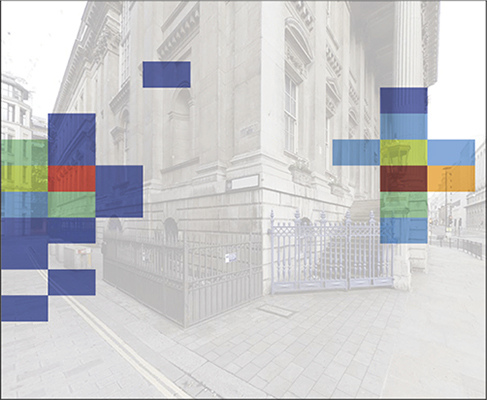Seeing the Axial Line: Evidence from Wayfinding Experiments
Abstract
:1. Introduction
1.1. The Role of Spatial Configuration on Wayfinding
1.2. Measuring Spatial Configuration through Space Syntax Analysis
1.3. Using Space-Geometric Measures to Assess the Role of Spatial Configuration on Wayfinding
1.4. Recording Eye Movements during Wayfinding
2. Method
2.1. Experimental Procedure
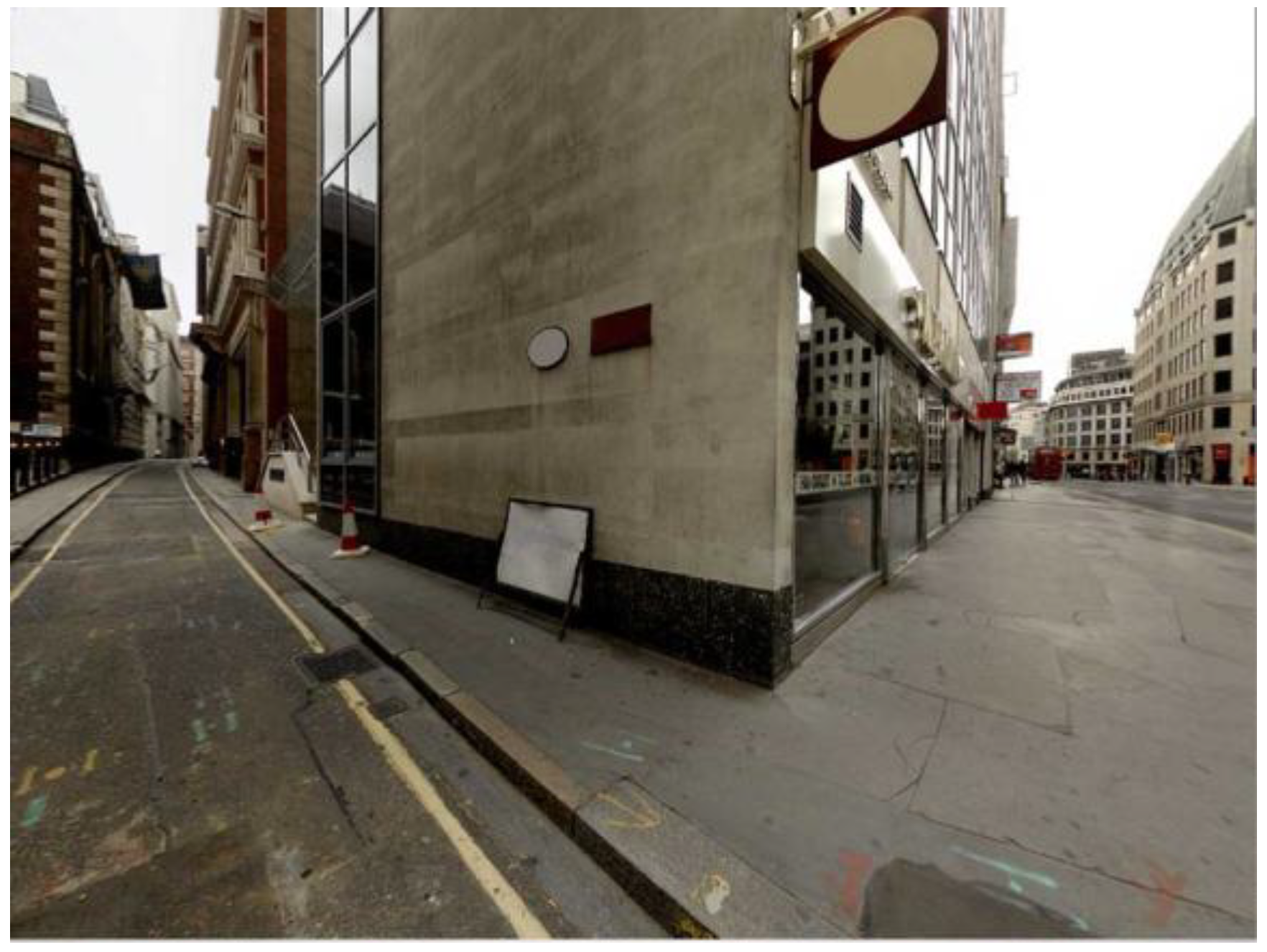
2.2. Analytic Methods
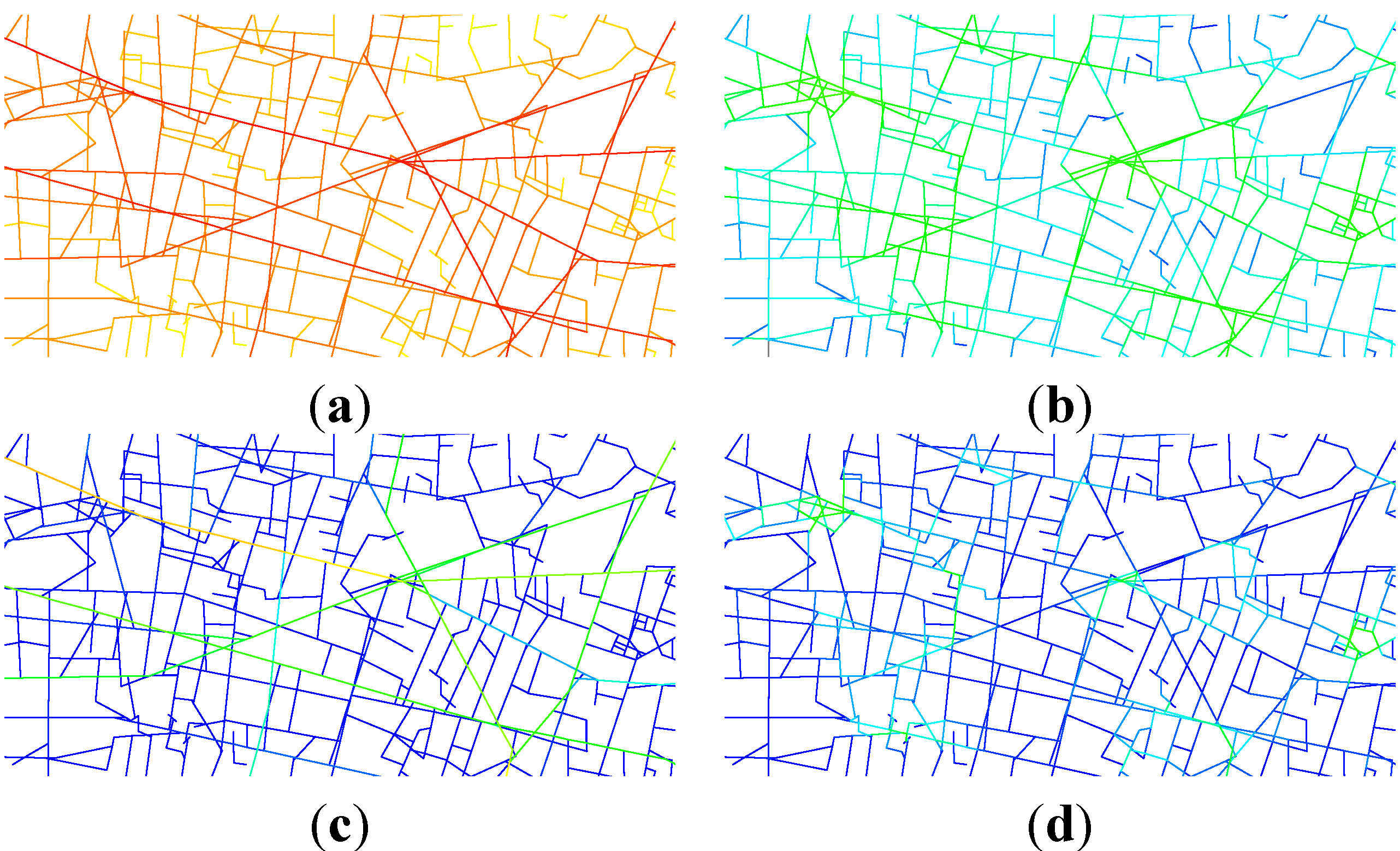
3. Results
3.1. Behavioural Data
| Integration r = n | Integration r = 100 m | Choice r = n | Choice r = 100 m | |
|---|---|---|---|---|
| No. of decisions | 21.53 | 19.93 | 19.67 | 15.14 |
| % | 76.90 | 71.19 | 70.24 | 54.05 |
| p-value | <0.01 | <0.01 | <0.01 | <0.02 |
3.2. Eye Tracking Data
3.2.1. Time Course Pattern
3.2.2. Location of Fixations
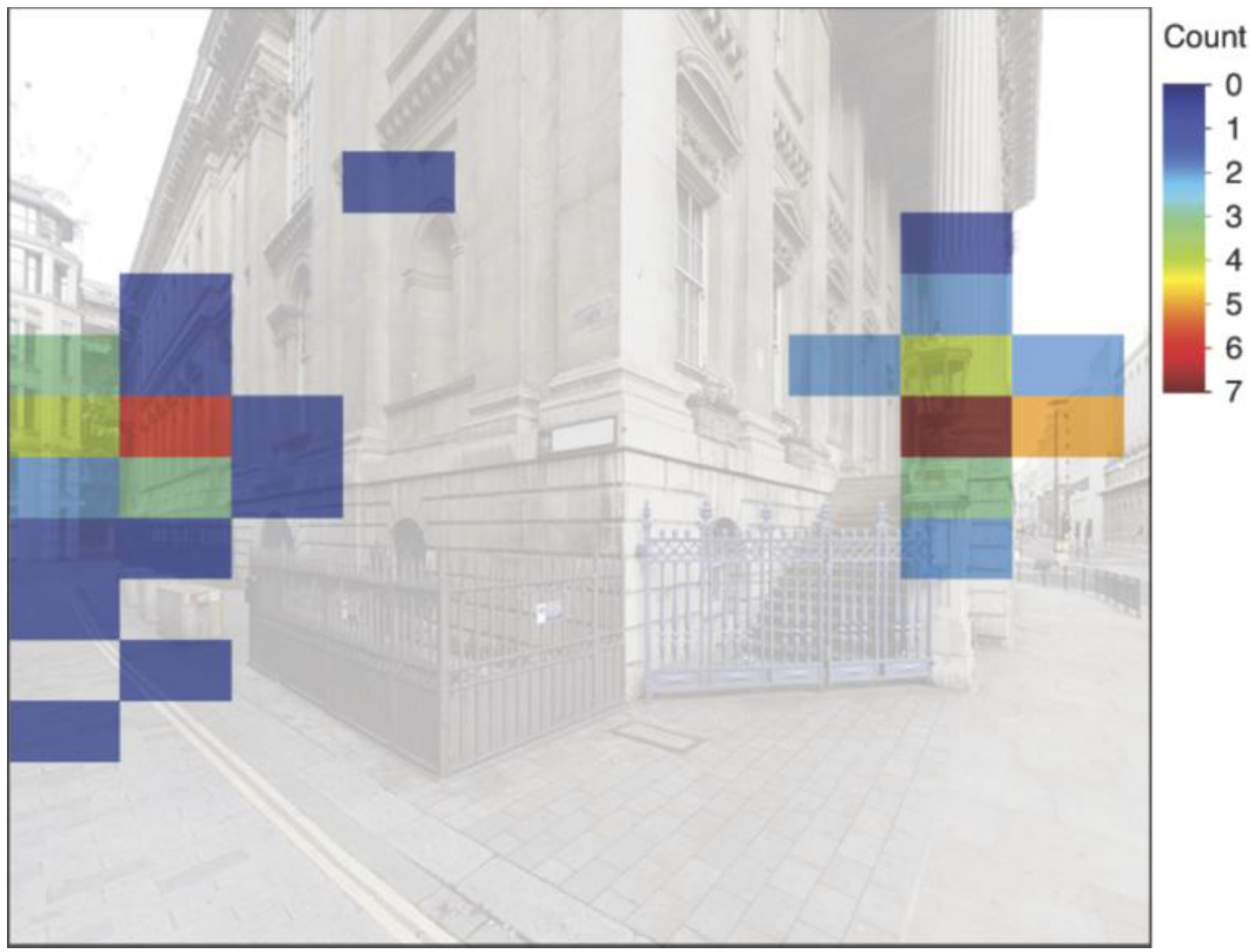
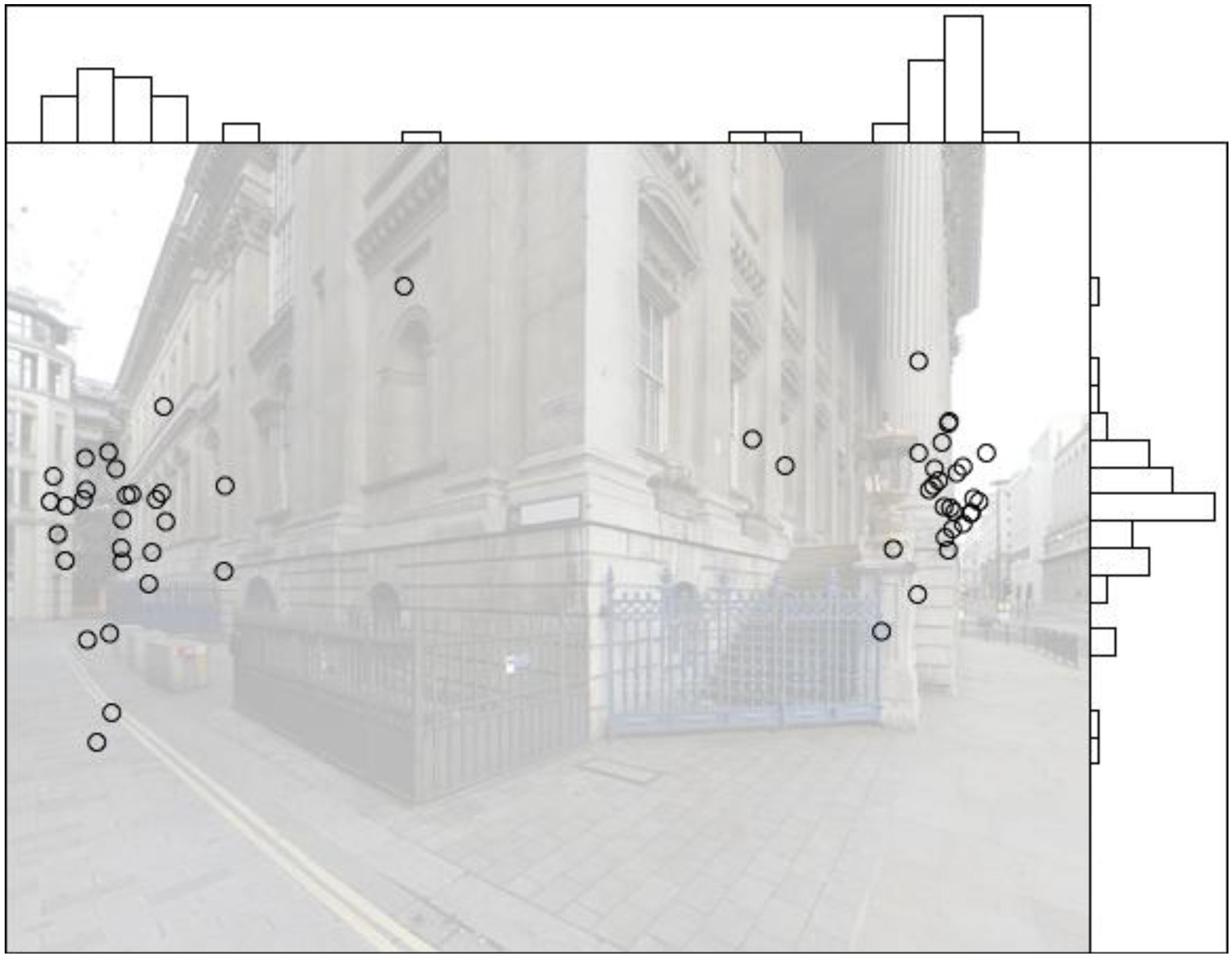

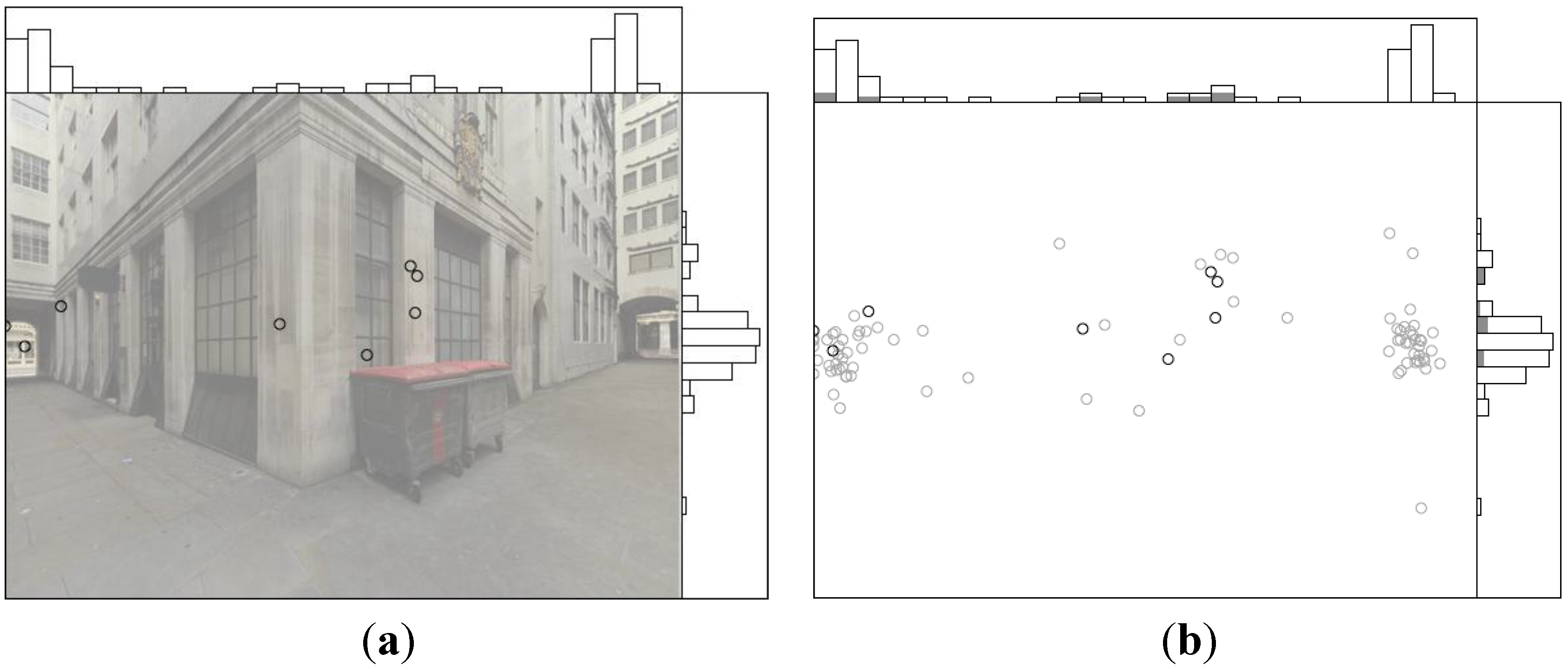
4. Discussion

5. Conclusions
Acknowledgments
Conflicts of Interest
References and Notes
- Penn, A. Space syntax and spatial cognition. Environ. Behav. 2003, 35, 30–65. [Google Scholar] [CrossRef]
- Montello, D.R. Spatial Cognition. In International Encyclopedia of the Social and Behavioral Sciences; Smelser, N., Bates, P., Eds.; Elsevier Science: Amsterdam, The Netherlands, 2001; pp. 14771–14775. [Google Scholar]
- Lynch, K. The Image of the City; MIT Press: Boston, MA, USA, 1960. [Google Scholar]
- Weisman, J. Evaluating architectural legibility. Environ. Behav. 1981, 13, 189–204. [Google Scholar] [CrossRef]
- Hillier, B. Space is the Machine: A Configurational Theory of Architecture; Cambridge University Press: Cambridge, UK, 1996. [Google Scholar]
- Hillier, B.; Hanson, J. The Social Logic of Space; Cambridge University Press: Cambridge, UK, 1984. [Google Scholar]
- Conroy, R. Spatial Navigation in Immersive Virtual Environments. PhD Thesis, University College London, London, UK, 2001. [Google Scholar]
- Peponis, J.; Zimring, C.; Choi, Y.K. Finding the building in wayfinding. Environ. Behav. 1990, 22, 555–590. [Google Scholar] [CrossRef]
- Haq, S.; Zimring, C. Just down the road a piece. Environ. Behav. 2003, 35, 132–160. [Google Scholar] [CrossRef]
- Hölscher, C.; Brösamle, M.; Vrachliotis, G. Challenges in multilevel wayfinding: A case study with the space syntax technique. Environ. Plan. B Plan. Des. 2012, 39, 63–82. [Google Scholar] [CrossRef]
- Dalton, N. Fractional Configurational Analysis and a solution to the Manhattan problem. In Proceedings of the Third International Space Syntax Symposium, Atlanta, GA, USA, 7–11 May 2001; Peponis, J., Wineman, J., Bafna, S., Eds.; Alfred Taubman College of Architecture and Urban Planning, University of Michigan: Atlanta, GA, USA, 2001. [Google Scholar]
- Turner, A.; Dalton, N. A simplified route choice model using the shortest angular path assumption. In Proceedings of the Geo-Computation, Ann Arbor, MI, USA, 31 July–3 August 2005; Xie, Y., Brown, D.G., Eds.; GeoComputation CD-ROM: Ann Arbor, MI, USA, 2005. [Google Scholar]
- Hillier, B.; Iida, S. Network and psychological effects in urban movement. In LNCS; Cohn, A., Mark, D., Eds.; Springer: Berlin Heidelberg, Germany, 2005. [Google Scholar]
- Harary, F. Graph Theory; Addison-Wesley: Reading, MA, USA, 1969. [Google Scholar]
- Tandy, C.R.V. The isovist method of landscape survey. In Symposium of Methods of Landscape Analysis; Murray, H.C., Ed.; Landscape Research Group: London, UK, 1967; pp. 9–10. [Google Scholar]
- Benedikt, M.L. To take hold of space: Isovists and isovist fields. Environ. Plan. B Plan. Des. 1979, 6, 47–65. [Google Scholar]
- Peponis, J.; Weisman, J.; Rashid, M.; Hong Kim, S.; Bafna, S. On the description of shape and spatial configuration inside buildings: Convex partitions and their local properties. Environ. Plan. B Plan. Des. 1997, 24, 761–781. [Google Scholar]
- Peponis, J.; Wineman, J.; Bafna, S.; Rashid, M.; Kim, S.H. On the generation of linear representations of spatial configuration. Environ. Plan. B Plan. Des. 1998, 25, 559–576. [Google Scholar]
- Turner, A.; Doxa, M.; O’Sullivan, D.; Penn, A. From isovists to visibility graphs: A methodology for the analysis of architectural space. Environ. Plan. B Plan. Des. 2001, 28, 103–121. [Google Scholar] [CrossRef]
- Batty, M. Exploring isovist fields: Space and shape in architectural and urban morphology. Environ. Plan. B: Plan. Des. 2001, 28, 123–150. [Google Scholar] [CrossRef]
- Wiener, J.M.; Franz, G.; Rossmanith, N.; Reichelt, A.; Mallot, H.A.; Bülthoff, H.H. Isovist analysis captures properties of space relevant for locomotion and experience. Perception 2007, 36, 1066–1083. [Google Scholar]
- Franz, G.; Wiener, J.M. From space syntax to space semantics: A behaviorally and perceptually oriented methodology for the efficient description of the geometry and topology of environments. Environ. Plan. B Plan. Des. 2008, 35, 574–592. [Google Scholar] [CrossRef]
- Meilinger, T.; Franz, G.; Bülthoff, H.H. From isovists via mental representations to behaviour: First steps toward closing the causal chain. Environ. Plan. B Plan. Des. 2012, 39, 48–62. [Google Scholar] [CrossRef]
- Emo, B. The visual properties of spatial configuration. In Environmental Modeling: Using Space Syntax in Spatial Cognition Research; SFB/TR8 Report No. 026–12/2010; Proceedings of the workshop at Spatial Cognition 2010, Mount Hood, OR, USA, 15 August 2010; Dara-Abrams, D., Dalton, R.C., Hölscher, C., Turner, A., Eds.; University of Bremen: Bremen, Germany, 2010. [Google Scholar]
- Wiener, J.M.; Hölscher, C.; Büchner, S.; Konieczny, L. Gaze behaviour during space perception and spatial decision making. Psychol. Res. 2012, 76, 713–729. [Google Scholar] [CrossRef]
- Dalton, R.C. The secret is to follow your nose: Route path selection and angularity. Environ. Behav. 2003, 35, 107–131. [Google Scholar] [CrossRef]
- Golledge, R.G. Path selection and route preference in human navigation: A progress report. In Spatial Information Theory: A Theoretical Basis for GIS, Proceedings of the International Conference COSIT ‘95, Semmering, Austria, 21–23 September 1995; Frank, A., Kuhn, W., Eds.; Springer: Berlin Heidelberg, Germany, 1995; Volume 988, pp. 207–222. [Google Scholar]
- Itti, L.; Koch, C. Computational modelling of visual attention. Nat. Rev. Neurosci. 2001, 2, 194–203. [Google Scholar] [CrossRef]
- Yarbus, A. Eye Movements and Vision; Plenum: New York, NY, USA, 1967. [Google Scholar]
- Emo, B.; Hölscher, C.; Wiener, J.M.; Dalton, R.C. Wayfinding and spatial configuration: Evidence from street corners. In Proceedings of the Eigth International Space Syntax Symposium, Santiage de Chile, Chile, 3–6 January 2012; Greene, M., Reyes, G., Castro, G., Eds.; Pontificia Universidad Católica de Chile: Santiago de Chile, Chile, 2012. [Google Scholar]
- Zacharias, J. Path choice and visual stimuli: Signs of human activity and architecture. J. Environ. Psychol. 2001, 21, 341–352. [Google Scholar] [CrossRef]
- Wolbers, T.; Hegarty, M. What determines our navigational abilities? Trends Cognit. Sci. 2010, 14, 138–146. [Google Scholar] [CrossRef]
- Emo, B. Choosing the more connected street. Mimeo 2014, 1, 1–15. [Google Scholar]
- Turner, A. Depthmap, version 4.1; computer software; University College London: London, 2004. [Google Scholar]
- Haq, S. Investigating the syntax line: Configurational properties and cognitive correlates. Environ. Plan. B Plan. Des. 2003, 30, 841–863. [Google Scholar] [CrossRef]
- Turner, A. The ingredients of an exosomatic cognitive map: Isovists, agents and axial lines? In Proceedings of the Space Syntax and Spatial Cognition workshop, Bremen, Germany, 24 September 2006; Hölscher, C., Dalton, R.C., Turner, A., Eds.; University of Bremen: Bremen, Germany, 2006; pp. 163–180. [Google Scholar]
© 2014 by the authors; licensee MDPI, Basel, Switzerland. This article is an open access article distributed under the terms and conditions of the Creative Commons Attribution license (http://creativecommons.org/licenses/by/3.0/).
Share and Cite
Emo, B. Seeing the Axial Line: Evidence from Wayfinding Experiments. Behav. Sci. 2014, 4, 167-180. https://doi.org/10.3390/bs4030167
Emo B. Seeing the Axial Line: Evidence from Wayfinding Experiments. Behavioral Sciences. 2014; 4(3):167-180. https://doi.org/10.3390/bs4030167
Chicago/Turabian StyleEmo, Beatrix. 2014. "Seeing the Axial Line: Evidence from Wayfinding Experiments" Behavioral Sciences 4, no. 3: 167-180. https://doi.org/10.3390/bs4030167
APA StyleEmo, B. (2014). Seeing the Axial Line: Evidence from Wayfinding Experiments. Behavioral Sciences, 4(3), 167-180. https://doi.org/10.3390/bs4030167



